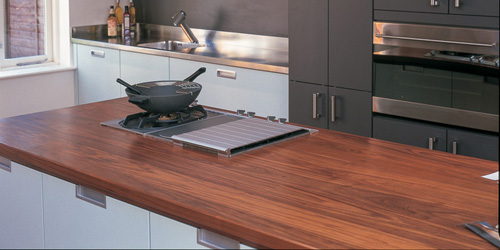
Having taken delivery of your soon-to-be prized wooden worktop, you’ll naturally want to keep it looking as perfect as possible. Wood is a versatile and stunning looking material and is easy to look after, once you know how to oil it and establish a pattern of maintenance.
From delivery be sure to keep your worktop in a room that is up to normal living temperature, rather than in a shed or garage. If you are lucky the manufacturer will have supplied a tin of oil, or you might need to pop to the hardware store. There are several types of oil and they do have slightly different properties, but they will all work for this purpose.
- Danish oil: A combination of oils such as Tung and Linseed. Danish oil gives a good level of protection and is fairly easy to apply. A very popular brand is Rustin’s Danish oil.
- Tung oil: From a tree found in China, Africa and South America. Tung oil does give great protection but takes longer to dry than other oils and can be a bit harder to apply. Common brands to look for here are Bestwood Tung oil and Liberon Tung oil.
- Linseed oil: From steamed and crushed flax seeds. Providing adequate protection, you will need to wait a long time between coats as it may take several days to dry. Rustin’s also do a good linseed oil.
- Teak oil: A mix of naturally occurring oils from vegetable products. This quick drying oil provides a good protection but has nothing at all to do with teak!

You need to start the oiling process before you install the work top. You will be oiling the worktop all over on both sides and paying special to the end grain sections at each end and any cut-outs (for sinks and hobs etc.).
Step 1 – Use a lint free cloth rather than a brush, an old t-shirt is perfect.
Step 2 – Putting a little oil on the cloth, oil the exposed edges first. If you don’t do these first, drip marks may show up afterwards. Oil the sides of the cut-outs at this point as well.
Step 3 – Pour a small amount of oil directly onto the wooden surface. Working with the grain (in the same direction as the grain, rather than across it), you are aiming for a thin, even and consistent coating all over the surface. You should find this fairly easy to achieve if you start with small amounts and avoid leaving large pools of oil on the surface for a long time. Oil around cut-outs and the end grain sections.
Step 4 – Wait for 10 minutes. Using the same cloth, but this time with no extra oil, go over the surface again. The cloth should glide easily over the surface. If it feels like it’s not, apply a little more oil to that section. It’s quite normal for different parts of the worktop to absorb oil at different rates. Oil the cut-outs and end grain sections again.
You’ll notice that you are oiling the end grain edges twice as much as the main surfaces. This is because the end grain sections will absorb more oil than the top and bottom surfaces.
Using the above steps, oil the bottom surface twice and the top surface four or five times. After the first coat the oil (which might be dry in as little as 30 minutes depending on a range of factors), the second and subsequent coats will take longer. Don’t be tempted to put the next coat on before the last one has dried; oil hardens as it dries and adding the next coat of oil too soon will mean it takes longer to harden.
After installation the top surface may need one or two more coats. From this point on, you may not need to oil it again for three to six months. You’ll know it’s time to re-oil when water stops “beading” on the surface.

The initial care and attention you show the worktop will be worth it, you’ll receive a life time of service from this amazing natural material in return.
Jon Buck has been managing director at Bordercraft since 1996. Bordercraft are a family owned business and have been producing fine hardwood furniture from their workshops in the Welsh borders since 1972. All of the timbers they use are sourced from sustainable managed forests and everything they sell is made by their experienced craftsmen in the UK.